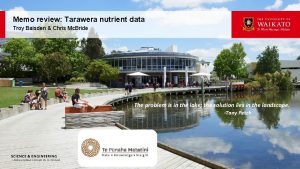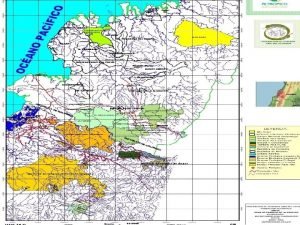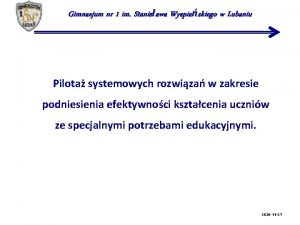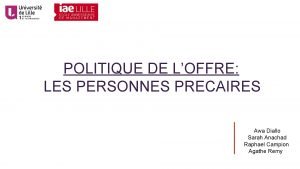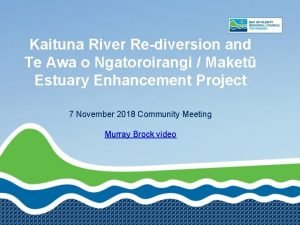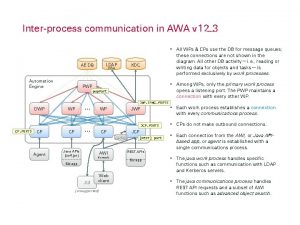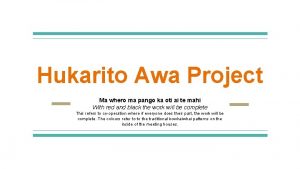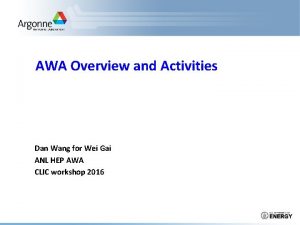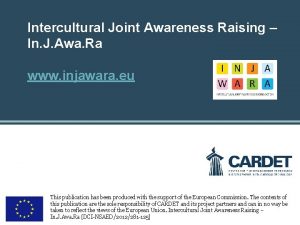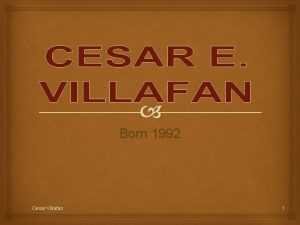Ko Tarawera te munga Ko Utuhina te awa



























- Slides: 27

Ko Tarawera te māunga. Ko Utuhina te awa. Ko Clifford tōku waka. No Rotorua ahau. Ko Ngati Pākeha, raua ko Ngati Dutch raua ko Ngai Tūhoe oku iwi. Ko tāku kāinga i roto i Tāmaki Makaurau. Ko Wayne rāua ko Wilma ōku matua. Ko Meadow tāku kuri. Ko Sheree Veysey tāku ingoa.

Resource and Research Sheree Veysey Mental Health Promotion Lead. BCS, Member NZAC, PG Dip Counselling, Masters of Social Practice

What • Community Partnership Fund Project • Reduce stigma & discrimination, increase social inclusion • Written to be facilitated by people in the community (teachers, youth workers etc. ) with youth aged 15 -24 years • Five group exercises with various activities


Facilitator Videos 1. The messages; Like Minds, Like Mine main messages (9 min) 2. Challenging conversations; Safety! Keeping conversations safe (7 min) 3. Sharing your story? How and if to share your own experience of mental distress (5 min) Youtube and via website

1. What is mental illness? (Required Activity) A. Group sets up an agreement for safe conversations. B. Group brainstorms places where young people can go for help. Facilitator gives help card with numbers and websites C. Facilitator leads an activity around four different definitions of mental illness followed by discussion.

1. What is mental illness? Required Activity)

Attitude Statements (Foundational Activity 2) • Defines stigma and discrimination. • Young people discuss various cards with stigma’s • “Dangerous”, “weak”, “never get better”, “weird” etc. • Accompanying cards challenge the stigma and encourage empathy or new perspective.


Turning up the Volume • Examines the ways in which what we see as mental illness/distress symptoms can be related to everyday experiences. • Includes listening to the story of Peter, who experienced psychosis after drug use.

Fresh Eyes • Helps participants consider the ways culture can impact on experiences of mental distress — in particular, food and body issues. • Participants watch or act a play about aliens that provides an ‘outsider’ view. • A card activity educates and encourages awareness about how cultural/when and where we live influences how we understand mental distress.


Building Wellness • Introduces Te Whare Tapa Whā, and Fonofale • Uses audio or video of young people sharing their mental health journeys. • Worksheet encourages participants to look at their own wellbeing


Project process Best practice: Plan evaluation at design stage High School partners Study Design Validated Measure

Reported and Intended Behaviour Scale, (RIBS) Graham Thornicroft, 2009

Project process Study Design Best practice: Plan evaluation at design stage Validated Measure Ethics, information sheet, voluntary High School partners Control group plus intervention group Pilot version of resource Pilot one: Community *Consultation *Feedback *Learning Improved pilot version Pilot two: MAINZ Statistical analysis Finalised resource Sancta Maria College n=8 (Survey not RIBS) Pre intervention Post intervention Three month follow up survey

Study - Initially partnered high schools - Utilized RIBS 10 (Thornicroft 2009) with qualitative question added. Pilot One Papakura setting Recruited in community Wide recruitment – small response Facilitator with lived experience, used to mental health facilitation Intervention participants: n=5 Control: n=4 Pilot Two Music and Audio Institute of NZ Foundation Music and Audio class and control Live Sound class Facilitated by five tutors with no experience in mental health facilitation Intervention participants: n=20 Control: n=16 Reported and Intended Behaviour Scale, (RIBS) Graham Thornicroft, 2009

Did the research show change? Statistically: results inconclusive. Why? ? Not enough stigma in the first place? Sample size Dose dependant? Is RIBS the best measure to capture this area for NZ young people? Characteristics of the Resource didn’t work? … groups studied? … Social desirability bias?

Before and after… Exactly the same on the “reported and intended behaviour” Likert scale before and after. Before: No, or I don’t know if I: live, work, or have a No or don’t know: live, work, or have a neighbour or close friend with mental illness Before: What words come to mind to describe someone who experiences mental illness/distress/mental health problems: I feel it should be looked into and treatment cause it They areprovided people. ASP that need effects everyone around them. help. Versus. After: Yes, Don’t know, Yes, No Versus After: I want them to feel better and help Versus After: them in whichever way I could/can. Support. reassure. We need. Comfort to live in and a world where we can help Respect. and reach out for help. to open up. Ask. Encourage for help. Be supportive.

What do we know? §Resource written in line with what’s recommended– giving people a frame to interpret experiences §Power of contact - with limitations §Positive signs in qualitative feedback Ashton, L. Gordon, S & Reeves, R. (2015). Methods and messages of interventions to counter stigma and discrimination, awaiting publication, University of Otago.

Repeated messages over time. . . Thornicroft, G. Mehta, N. Clements, S. , Evans-Lacko, S. , Doherty, M. , Rose, D, … & Henderson, C. (2016). Evidence for effective interventions to reduce mental-health-related stigma and discrimination. The Lancet 387 (10023), 1123 -1132. Mehta, N. , Clements, S. , Marcus, E. , Stona, A. C. , Bezborodovs, N, , Evans-Lacko, S. , … & Koschorke, M. (2015). Evidence for effective interventions to reduce mental health-related stigma and discrimination in the medium and long term: Systematic review. The British Journal of Psychiatry. , 207 (5), 377 -384.

Learning from the process • Design to have “captive” survey completion. • If possible test measure with group to see if sensitive enough • Research then with group displaying “high stigma”. • Think about providing all surveys in a “faceless” way (tablet/phone)- decrease any social desirability bias effect

What people have said: Rangatahi having “ - Greater awareness and empathy for whanau experiencing mental unwellness and what their response may be to support them Greater awareness of the interaction between Alcohol and Other Drugs and mental illness, giving greater perspective than just ‘druggies’ and ‘psychos’ Facilitator, Thames.

“I liked the definition match activity as we got to see other people’s perspective, but I also liked the thought provoking discussions” “ I was surprised to find that the students [Iresponded to it as mature young adults …I liked] “hearing the audio of [young people’s] struggles. Seeing perspectives of others, their viewpoint. ” think it's a credit to the resource & activities “It [mental distress]can be like a roller coaster”… “but people get that they stayed focussed and contributed better” maturely. ” “What I found interesting is accepting and supporting and respecting others on who they are and whatever culture they - Facilitator of pilot MAINZ come from. ” “I have learned about other people’s perspective and more understanding about where they’re coming from. ”

“They just tell you what you ‘are’ …they don’t tell you …. all this…” (gestures to activities that encourage critical thinking about how we define mental distress/illness)

• Download or check out the resource at rethink. org. nz/conversationsforchange • We’re excited – but we need your help to get this into communities. • Share postcards and flyers • Follow Re. THi. Nk. NZ on Facebook to keep up-to-date sheree@mindandbody. co. nz rethink@mindandbody. co. nz



